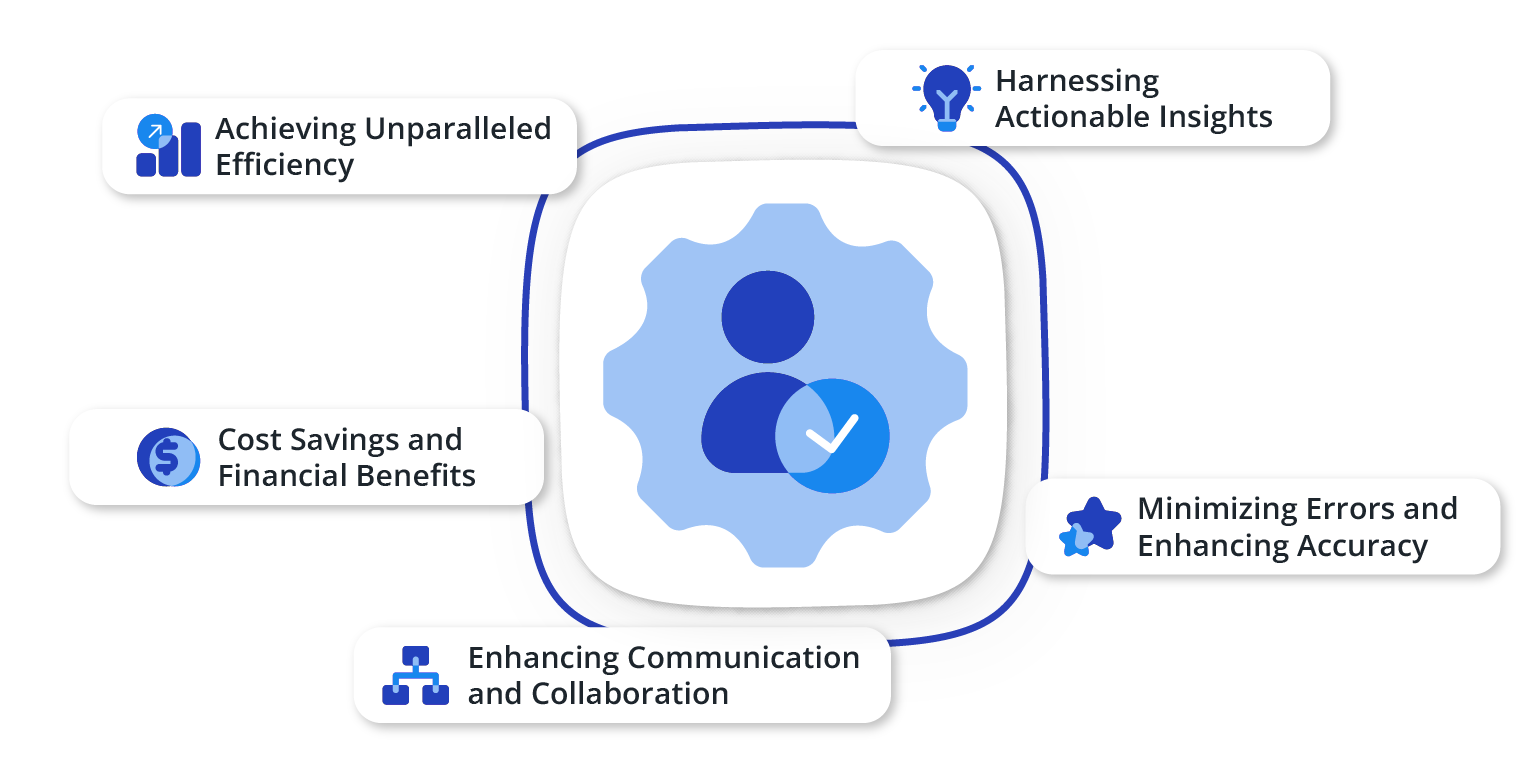Human resource (HR) automation has proven itself to be a game-changing advancement in business operations. By integrating automation into HR practices, organizations can eliminate tedious manual tasks, streamline operations, and enhance overall efficiency.
As an HR professional, a C-level executive, an HR software developer, or a product manager, it’s crucial to understand HR automation’s nuances, benefits, challenges, and practical applications.
Process Automation in HR
Process automation in HR brings a modern approach to replacing traditional, manually intensive tasks. It goes beyond simplifying administrative work and completely transforms how human resources operate. By adopting automation, HR becomes more agile, adapting to the changing needs of organizations efficiently.
The Evolution of HR Process Management
In the past, HR relied heavily on paper-based, manual processes that were time-consuming, error-prone, and inefficient. However, recent advancements in technology, particularly AI and machine learning, have led to the adoption of automated HR processes.
This shift enables streamlined, efficient, and error-free operations, putting HR teams in a powerful position. Freed from managing mundane administrative tasks, they now have more time to focus on strategic roles such as talent management, succession planning, and organizational development, which contribute significantly to the company’s growth and success.
Why Invest in Automation for HR?
As businesses face growing competition, they seek new ways to gain a competitive edge. They now recognize that HR, once seen as a cost center, can become a strategic asset through automation.
Investing in HR automation offers a host of benefits. Firstly, it significantly reduces the time and resources spent on routine tasks, leading to cost-effectiveness. Secondly, it streamlines HR processes, making them quicker and less prone to errors.
Furthermore, HR automation improves employee engagement and experience through better onboarding, seamless benefits administration, efficient performance management, and prompt problem resolution. This, in turn, boosts productivity and business performance.
In-Depth Analysis: HR Automation Benefits
Digging deeper into the subject, we can identify several benefits of HR automation that impact various aspects of HR operations.
Achieving Unparalleled Efficiency
HR automation frees HR personnel from repetitive tasks to focus on more substantial and strategic roles. By automating tasks like data entry, leave management and performance tracking, HR teams have more time for strategic thinking, decision-making, and addressing employees’ needs.
This improved efficiency creates a ripple effect throughout the organization, driving better productivity, increased employee engagement, and a more positive work culture.
Harnessing Actionable Insights
Data is the new oil in the digital economy, and HR automation is a goldmine of valuable data. Modern HR tools have analytics capabilities to uncover insights like predicting turnover, identifying skill gaps, and understanding employee engagement levels.
By leveraging these insights, organizations can make data-driven decisions and continuously refine their HR strategies for superior outcomes.
Minimizing Errors and Enhancing Accuracy
Manual data handling leaves room for human error, which can lead to inconsistent and inaccurate results. HR automation offers an effective solution by standardizing processes and eliminating manual entry. It ensures greater precision in tasks like payroll computation, benefits administration, and recordkeeping.
The result is a more reliable, transparent, and fair HR process that boosts employee confidence and trust.
Enhancing Communication and Collaboration
Effective communication is pivotal to the success of any team, and HR is no exception. HR automation tools enable seamless communication between HR teams, managers, and employees, reducing miscommunication or information silos.
Automated feedback reminders, transparent leave tracking, and instant policy updates are just a few examples of how automation can enhance communication. The result is a more collaborative organization aligned toward common goals.
Cost Savings and Financial Benefits
Beyond the invaluable time saved, automated HR also has direct financial benefits. By automating labor-intensive tasks, organizations can significantly reduce reliance on paperwork and manual labor, leading to substantial cost savings.
Furthermore, the increased accuracy and speed of automated processes can prevent costly errors and inefficiencies. These financial benefits can be reallocated to other strategic areas, promoting business growth.
Practical Applications: HR Automation Examples
Several aspects of HR can be streamlined using automation.
Automated Payroll
Business Automated payroll transforms a traditionally complex process into a smooth, reliable system.
Automated Payroll Processing
Automated payroll processing ensures employees are paid accurately and on time, reducing manual errors and saving hours of calculation.
Tax Preparation & Filing
HR automation simplifies tax preparation and filing, ensuring compliance and accuracy while reducing the burden on HR teams.
Efficient Employee Onboarding and Offboarding
Automated onboarding simplifies the integration of new hires, creating a smooth and welcoming start. Offboarding automation can ensure a respectful and efficient separation, maintaining positive ties with departing employees.
Document Management
Automation can handle document management, ensuring important paperwork is completed, stored, and accessible when needed.
Training Modules
Automated training modules offer consistent, flexible training, allowing new hires to get up to speed at their own pace.
Exit Survey
Automated exit surveys gather valuable feedback from departing employees, providing insights to improve retention.
Digital Checklist
An automated digital offboarding checklist ensures no steps are forgotten, protecting both the company and the employee.
Streamlined Recruiting and Hiring
HR automation can streamline the recruitment process, making it faster and more effective.
Automate Job Postings
Automated job postings ensure vacancies are broadcasted quickly and widely to attract top talent.
Resume Screening
Automation can expedite resume screening, quickly identifying the most qualified candidates from a large pool of applications.
Chatbots for Preliminary Interviews
Chatbots can conduct preliminary interviews, assessing basic qualifications and saving recruiters’ time for more promising candidates.
Performance Management
Performance management is made easier with HR automation.
Automated Feedback Surveys
Automated feedback surveys provide continual feedback from employees, fostering a culture of growth and improvement.
Performance Analytics
Performance analytics provide quantitative data on employee performance, informing management decisions and helping identify high performers.
Time, Leave, and Expense Management
HR automation can make time, leave, and expense management simple and efficient.
Automated Time Tracking
Automated time tracking provides accurate insight into employee working hours, ensuring fairness and transparency.
Leave Management
Automation simplifies leave management, allowing employees to easily request time off and managers to smoothly handle these requests.
Simplified Approval Process
HR automation can simplify the approval process, making it easy for managers to review and approve expenses, leave requests, and more.
Navigating Challenges in HR Automation
While it is powerful, it comes with some challenges. Effective management of these issues can help organizations harness its immense potential.
Recognizing Potential Pitfalls
Like any technological solution, automation in HR has potential pitfalls. One of them is the risk of over-reliance on technology, which may result in a loss of empathy and the human touch.
Furthermore, the use of AI in recruiting processes can inadvertently introduce biases if algorithms are trained on biased data. Also, while automation reduces human errors, it’s not immune to system errors or bugs that can have a significant impact if not resolved quickly.
For optimal results, maintaining a balance between automated and manual processes is crucial. While automation can handle routine tasks, human intervention is still essential for strategic decision-making and dealing with complex human emotions.
Ensuring Positive Candidate and Employee Experiences
As organizations automate their HR processes, they must ensure that the shift doesn’t negatively impact candidate and employee experiences. While it’s possible to automate many aspects of HR, nothing can replace the personal, human touch integral to HR.
For example, in recruiting chatbots can provide instant responses to candidate queries, but human interaction is essential for in-depth interviews and final hiring decisions.
Similarly, in employee engagement and grievance redressal, automated surveys can collect feedback, but it takes a human touch to deeply understand and address complex employee issues.
In essence, while automation can facilitate HR processes, it’s important to integrate it wisely into the workflow, ensuring it enhances rather than replaces the human connection. Using technology should create more room for empathy, understanding, and connection, improving the overall human experience.
Selecting the Right HR Automation Tool
A crucial part of implementing HR automation is choosing the right tool that aligns with your organization’s needs and goals.
Understand Your HR Needs
Before diving into automation, organizations need to identify their specific HR challenges and objectives. This will help you select an HR automation tool that aligns perfectly with your needs.
Look for These Features in HR Automation Tools
Scalability
Scalability is a must-have feature in any HR automation tool. The right tool should grow and adapt as your organization expands and your needs evolve.
Integration Capabilities
HR tools should have robust integration capabilities, allowing seamless connection with other systems and software used in the organization. This feature ensures a unified and efficient workflow.
User-Friendliness
A user-friendly interface is crucial for easy use and quick adoption of the tool across the organization. It should simplify tasks, not complicate them.
Reporting and Analytics
Reporting and analytics are necessary to gain insights into HR processes. A good automation tool should provide intuitive reports and meaningful analytics to support data-driven decisions.
Compliance and Security
Compliance and security are paramount. The HR automation tool should comply with legal requirements and best practices to protect sensitive employee data.
Evaluate and Compare Vendors
Comparing vendors goes beyond just the features and price. Look at aspects like customer support, user reviews, and the overall reputation of the vendor.
Importance of Employee Training
Proper employee training is a critical step to ensure the HR automation tool is used to its fullest capability. A well-trained team can effectively leverage automation tools, maximizing their benefits.
Measure Success and ROI
Measuring the success and ROI of the HR automation tool is essential for continuous improvement. Regular evaluation helps identify areas of success and opportunities for further optimization.
The Future Landscape of HR Automation
As we look to the future, the continuous evolution of HR processes mandates the need to stay updated with the latest trends in HR tech and automation.
Kizen is here to be your trusted partner in this journey. Embrace the power of HR automation for efficient, accurate, and strategic HR operations. Contact us today to discuss your specific needs and explore how we can customize automation for your organization.










